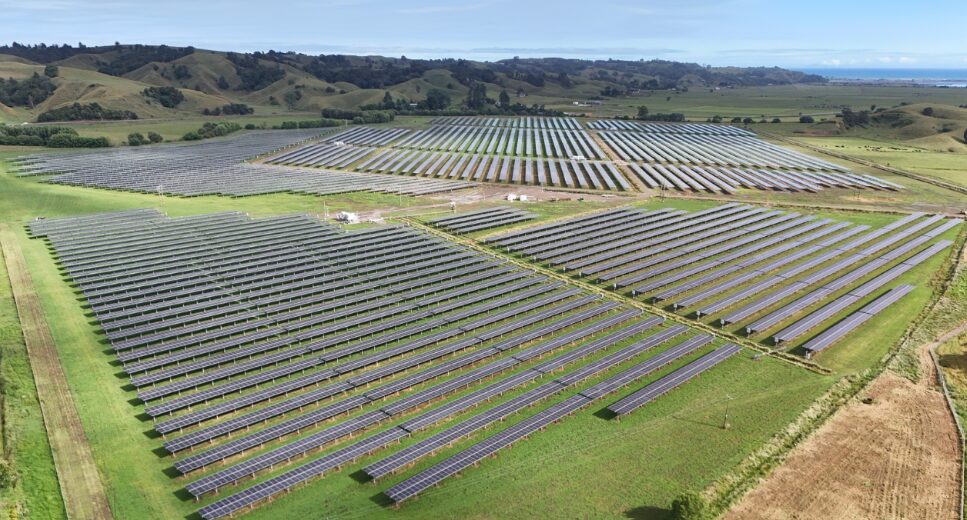
New Zealand solar PV developer Lodestone Energy has energised its largest solar power plant to date: the 42MW Te Herenga o Te Rā site in the Bay of Plenty, a large bight on New Zealand’s northern island.
The solar PV plant’s energisation was confirmed on Tuesday (14 January). Construction on the development started in December 2023, following the first generation of Lodestone’s inaugural 33MW solar PV plant, Kohirā in Kaitaia. The site has the potential to generate around 69GWh of renewable energy annually.
Try Premium for just $1
- Full premium access for the first month at only $1
- Converts to an annual rate after 30 days unless cancelled
- Cancel anytime during the trial period
Premium Benefits
- Expert industry analysis and interviews
- Digital access to PV Tech Power journal
- Exclusive event discounts
Or get the full Premium subscription right away
Or continue reading this article for free
The plant incorporates agrivoltaics into its design, a method of optimising the land use on which the modules sit for agricultural practices such as sheep grazing and crop production.
Te Herenga o Te Rā’s design sets the modules widely apart and high above the ground, allowing machinery to operate and grazing or horticultural activities to continue around them.
Lodestone’s Te Herenga o Te Rā development is also unique in the New Zealand market because it is the country’s first solar PV plant to be connected directly to the national grid, which is owned by state-owned company Transpower New Zealand. This grid stretches 11,803km and includes the HVDC Inter-Island link connecting the north and south islands through the Cook Strait.
Lodestone’s other operational solar PV power plants in New Zealand, the aforementioned Kohirā and the 32MW Rangitaiki plant, also situated near the Bay of Plenty, are connected to local distribution networks. The company’s fourth solar PV plant, a 32MW development currently under construction in Whitianga, will connect to the Powerco distribution network.
The Rangitaiki PV plant also incorporates agrivoltaics by featuring raised modules mounted on trackers, allowing sheep to graze beneath them. The modules in question are Trina Solar Vertex bifacial modules mounted on TrinaTracker’s Vanguard 2P tracker systems.
It is also worth noting that the Auckland-based company is currently developing a 220MW agrivoltaics plant on New Zealand’s south island.
New Zealand’s 2024 ‘energy crisis’ grants solar PV an opportunity
Much of the New Zealand grid is dominated by hydroelectric power plants, most of which are situated on the country’s southern island. This reliance on hydroelectricity, however, caused an energy crisis last year, with a dry year significantly reducing the output of these plants. In turn, wholesale electricity prices shot up as the country became ever reliant on oil and gas.
The turbulence last year now presents an opportunity for solar PV, wind, and energy storage to secure a more prominent role in the island nation’s electricity mix, something Sarah Gillies, chief executive of the Electricity Authority, spoke with PV Tech Premium about last year.
Gillies told PV Tech that more investment is needed to support and stabilise New Zealand’s electricity system, with the next 12-24 months set to “continue to be challenging”.
“We need more investment in generation and to harness opportunities from new technologies and demand response to keep the lights on at an affordable price. Looking ahead, we continue to need a combination of fuels and the supply,” Gillies said.
Echoing these thoughts, Lodestone Energy’s managing director, Gary Holden, highlighted the important role solar PV will have in driving down energy costs in New Zealand and called for additional government policy and support to incentivise further developments.
“Utility-scale solar is the lowest cost form of energy, and the country will need significant volumes of new solar in order to build a more resilient, secure, lower cost energy system,” Holden said.
“As Lodestone continues to lead investment in the country’s renewable electricity generation, it was critically important that policy and market settings encouraged investor capital into the sector and enabled developments to be executed faster.”
The company has lofty ambitions in the New Zealand energy market, eyeing a generation capacity of 800GWh annually by 2038.






